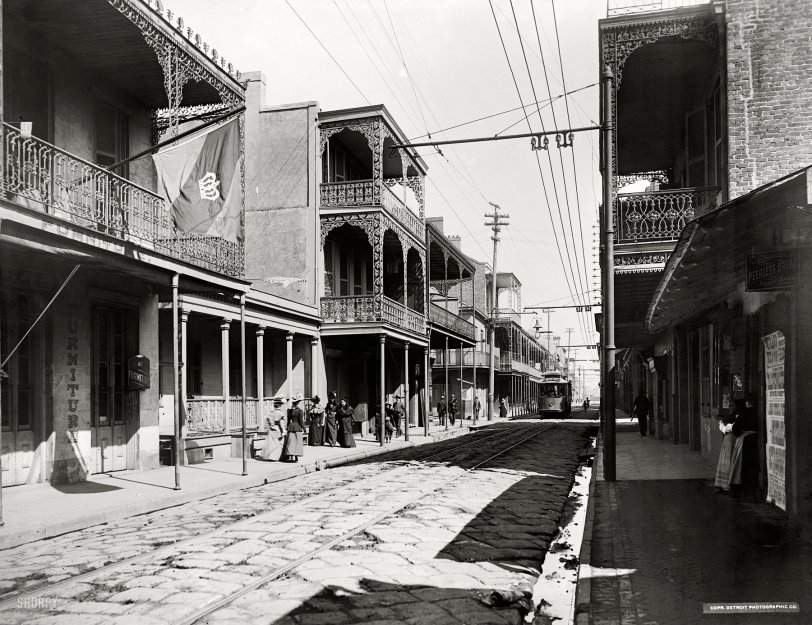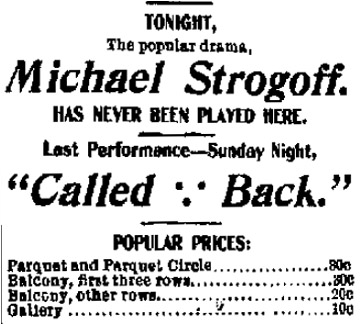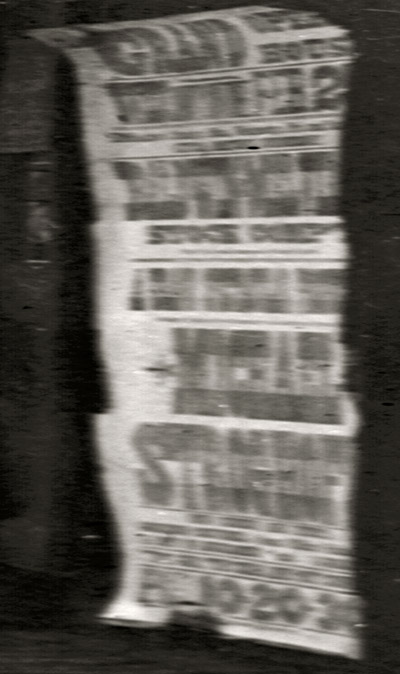


Framed or unframed, desk size to sofa size, printed by us in Arizona and Alabama since 2007. Explore now.
Shorpy is funded by you. Patreon contributors get an ad-free experience.
Learn more.

- Baldwin 62303
- Baldwin VO-1000
- Cold
- No expense spared
- Tough Guys
- Lost in Toyland
- And without gloves
- If I were a blindfolded time traveler
- Smoke Consumer Also Cooks
- Oh that stove!
- Possibly still there?
- What?!?
- $100 Reward
- Freeze Frame
- Texas Flyer wanted
- Just a Year Too Soon
- WWII -- Replacing men with women at the railroad crossing.
- Yes, Icing
- You kids drive me nuts!
- NOT An Easy Job
- I wonder
- Just add window boxes
- Icing Platform?
- Indiana Harbor Belt abides
- Freezing haze
- Corrections (for those who care)
- C&NW at Nelson
- Fallen Flags
- A dangerous job made worse
- Water Stop
Print Emporium
A Streetcar Named Clio: 1900

"Royal Street, New Orleans, circa 1900." The sign on the car reads CLIO ST. Who can tell us more? Detroit Publishing Company glass negative. View full size.
Not that expensive
Yeah, this is 1000 blk of Royal looking towards Esplanade, away from Canal (Canal street, uptown, is actually SW from this location and Esplanade, downriver, NE). I have a friend that has a condo with a balcony on the left side of this block- it ain't cheap, but not outrageous.
As far as Zamelli being Rex, I'd say that's highly, highly unlikely, as another commenter indicated, this lower part of the quarter was already known as little Palermo and fast becoming a slum at the time of the photo. The fancy furniture and antique shops were and are in the upper part of the quarter in the 200-500 blocks. There were many wealthy and prominent German Jews who came to New Orleans before the Civil War, but the Sicilians and eastern Jews that arrived in the late 1800s and early 1900s had generally not yet made their mark. OTOH, much of the French Quarter property is still owned by descendants of the Sicilian immigrants, and of course it's now quite valuable.
Mystery muck
Gutters or no, there are still plenty of pools of unidentifiable ooze in the streets. More since Katrina.
Lee Circle
Thanks for the Clio Line info, T Marcell.
I visit near Lee Circle regularly and I'd love to see a photo of that area from the same era or earlier, even if it never became a thriving arts district that Lafon had planned.
They will be heard
As an fyi, there are streets for all of the Muses.
Clio Line
Later part of the S. Clairborne line, its streetcars would take riders into the Central Business District, then into the Lower Garden District. As mentioned by MovieWatcher, it was named for one of the nine muses. Barthelemy Lafon designed the area in 1806-7 as an arts district with the streets leading to a central park. Tivoli Circle is also in this area. In 1877 the city passed an ordinance changing the name to Lee Circle for its giant statute of Robert E. Lee. The General faces due north because one can never turn his back on a Yankee.
King of Rex
It would appear that Mr. Zamelli was King of Rex at one time. I'm going on the fact that usually the owners of stores in this area lived in very elegant upstairs apartments in the French Quarter. I tried to find a listing of former Kings but couldn't. Is there someone out there better a searching than me? I would love to know of Mr. (and/or Mrs.) Zamelli was connected with Rex. Kathy
Little Sicily
1900 was the year that my great-grandfather died. This is photo was taken near their neighborhood at 629 Saint Philip Street. This could have been what the world looked like on his last day on the planet. Note the women in black on the sidewalk (banquette). They could have been on the way to the wake. The chubby one could be my great-grandmother; the others could be daughters. The French Quarter was known as the Sicilian Quarter or Little Sicily at the time. Gramps was "well respected in the Sicilian community," according to his obituary. This photo will be good to keep in my genealogical folder.
Ironwork porches
I would LOVE to find a setup like that for my house. I wonder what something like that would cost these days.
How'd you do that!
Thanks, Dave-- Your version of the "enhanced" poster is a lot more legible than mine!
R.O.S.
I love that -- "Shorpians." Count me as an expat in the Republic of Shorpy, forever visiting a foreign place and time.
Thanks again for all your efforts on behalf of the Republic.
French Opera House
The French Opera House was always known as such. It was on Bourbon at Toulouse from 1859 to 1919.
Americana 101
This picture, (and the many like it), combined with the informative comments, (and the many like them), make the SHORPY site one of the most fascinating on the internet! The way it taps into the tremendous wealth of regional and historical knowledge is a treasure. I'll say it again, "Thanks, Dave" and thanks to all SHORPIANS!
Cracked
This is the 1000 block of Royal, heading northeast towards Ursulines Avenue. The Scottish Bond brickwork on the building on the right still shows that white crack-repair job running up its left side after 108 years! Nice also to see that those stinky and disgusting gutters are gone.
The Clio Line
The Clio line was an early streetcar line, one of the first, if not the first, to cross Canal Street. I believe that it became part of the S. Clairborne line.
Much more at George Friedman's wonderful New Orleans streetcar site, "Canal Street: A Street Railway Spectacular".
http://www.cs.uiuc.edu/homes/friedman/canal/Canal.htm
Here's a shot down Royal a few years later:
The Nine Greek Muses
Nine New Orleans streets were named after the Greek Muses: Calliope, Clio, Erato, Euterpe, Melpomene, Polymnia, Terpsichore, Thalia and Urania. The locals pronounce the names differently, though. Mel-po-meen instead of Mel-pom-uh-knee, Terp-sih-core instead of Terp-sick-oree, Kal-eee-ope instead of Kuh-lie-oh-pee.
I love this photo
The city's gutters, now paved over, are streams of mostly rain and bayou water. When I was a kid, there were still parts of town where the gutters were exposed, and once in a while -- particularly after a heavy rain -- you'd see a crawfish swim by.
The street name "Clio" is variously pronounced "KLEE-oh," "KLY-oh," and (humorously) "C. L. ten".
Michael Stroghoff
A little Photoshop help suggests that the poster on the right is for a production of "Michael Stroghoff," perhaps a play based on the 1876 Jules Verne novel (often spelled as "Michael Strogoff"), at the Grand Theatre on Feb. 25. The novel was also made into a film in 1910; could this image be that late? I also see "10-20-30" at the bottom-- ticket prices?
[Those would be prices for a theatrical (opera house) production. Example below from 1898. - Dave]


A little more digging suggests that Michael Stroghoff was playing at the Grand Opera House, "which once stood on Canal Street."
Is that the same as the French Opera House, home of the New Orleans Grand Opera Company? The French Opera house burned in 1919.
What the flag meant
Until very recently--oh, say the 1960s or 1970s--the display of that particular flag, before Mardi Gras, in front of someone's home meant that a former King of Carnival (ex-Rex?) lived there. In 1900 or thereabouts, Royal Street was an adjunct to the Central Business District off of Canal street--the "Main Street" of New Orleans. Royal Street and the rest of the Vieux Carre were heading into a period of decline. By World War I, all of the Vieux Carre would be considered a slum, and definitely not yet a tourist attraction. But if the Mardi Gras flag always hung in front of the home of an ex-Rex, why is it here hanging in front of a furniture store? Notice that the flag is attached to the balcony--there have always been apartments on the second floor above the businesses on the first floor, many of the apartments quite luxurious, often the homes of the proprietors of the businesses below. This part of Royal Street has always been associated with furniture stores owned by one family: Mintz, Hurwitz-Mintz, and Mintz & Mintz are three firms I recall. The flag is quite believable at that location. Jewish citizens--such as the Mintzes--were very prominent in the early history of the Rex Organization--and the very first Rex in 1872 was Jewish. (see www.rexorganization.com)
Clio Car
You're right about the Mardi Gras flag and, judging on the heavier clothing being worn, it very well could be time for Carnival. This photograph looks down Royal Street into the French Quarter with Canal Street behind the photographer. The streets in the Vieux Carre are very narrow as can be seen here most are one-way. This streetcar is heading toward Canal Street where it will cross into the Central Business District, go up St. Charles Avenue, around Lee Circle, up a few blocks, and then turn onto Clio Street. It probably terminated near the train station and the then undreamt-of Superdome.
Inbound
The car is on Royal Street at Ursulines Avenue, inbound to Canal Street (11 blocks north). Clio Street is another 12 blocks or so north of Canal. There was a car barn in that vicinity. The scene is just like this today sans the cobble/brick street and street car.
[Below, the view on Royal just south of Ursulines. One building on the left in the old photo is gone, but everything else looks pretty much the same, even the ironwork. - Dave]
Mardi Gras!
That's the "Flag of Joy" (Mardi Gras flag) flying from the furniture store on the left. It is green-purple-yellow stripes (here diagonal) with a gold crown in the center.
























On Shorpy:
Today’s Top 5